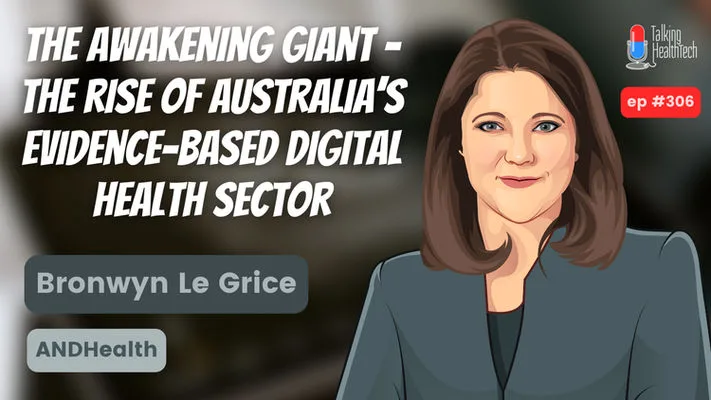Talking HealthTech: 306 – The awakening giant – The rise of Australia’s evidence-based digital health sector. Bronwyn Le Grice, ANDHealth

Source: talkinghealthtech.com

Provided by:
Talking HealthTech
Published on:
8 November 2022
A new industry analysis has been released by ANDHealth, Australia’s engine room for commercialising digital health. The paper, The Awakening Giant: The Rise of Australia’s evidence-based Digital Health Sector, will provide you with a greater understanding of Australia’s potential in digital health. And how we can speed up the use of technology to spur more innovation and help patients achieve better outcomes.
Bronwyn Le Grice, the CEO of ANDHealth, was kind enough to sit down with Talking HealthTech and take us through some of the report’s highlights and findings and what we might think about them.
The Giant Report Series
The intention to provide a follow-up to the 2020 research Sleeping Giant led to the development of this report. While the 2020 Industry report highlighted the global growth of the COVID-19 epidemic, it emphasised the commercialisation potential inside Australia’s digital health industry.
The most recent study examines the concept of an Awakening Giant in digital health, with pipeline businesses achieving 74% of growth over the past two years.
What is ANDHealth?
ANDhealth is a non-profit and non-equity-taking provider of commercialisation programs. The organisation offers programs that assist individuals in all stages of the innovation process, from concept generation to implementation. Since the company started in 2017, it has provided over 2,000 hours of program activities to more than 1,360 people.
The programs are either completely free to participants or heavily subsidised by public investment. Developing working relationships with a variety of companies to assist them in the collection of data and the provision of insights into various industry subsectors
To effectively promote innovation in health technology or any other field, you need to have access to reliable data to back up your claims. Providing decision-makers in government and private investors with the most substantial possible justification for investing in the company.
Evidence-based digital health
One of the most critical aspects of evidence-based digital health is the need for a product to amass a significant amount of evidence before it can attract customers. The economic viability of a product can be evaluated through clinical trials, healthcare studies, and other evidence-gathering activities by industries. It is assessing the product’s viability in various settings, such as different patient populations or markets, or determining whether or not the product will be commercially viable.
Since these companies are still in the pre-revenue growth phase, they have been in operation for a considerable time. This phase can run anywhere from three to ten years—extreme dependency on securing funding from other sources to maintain operations.
The report findings indicate that 85 percent of businesses have intentions to raise money within the next year, and six want to raise more than 10 million altogether. It should not come as a surprise that they are looking for capital because most new businesses go through a rough financial patch in their first few years of operation.
Digital Therapeutics
Digital therapeutics is still relatively new in Australia, and many businesses there do not consider themselves in this industry. The main reason for this is that the term “digital therapeutics” is not used very often in the country yet. There are undoubtedly quite a few digital therapeutics firms operating under the radar in this area that do not necessarily recognize themselves as digital therapeutics.
Since Covid, there has been significant development in the mental health field and in the methods through which telehealth services are funded. Many people who have mental illness are reluctant to seek medical help for their condition. People with mental health problems can use telehealth because it is a more secure treatment method.
Self-management of disease, medication adherence, and patient behaviour modification are all vital. It is known that the more engaged and active a patient is in their healthcare journey, the better the health results they will receive.
Clinical Decision Support
Changes in healthcare meant that 18% of people were working on solutions for clinicians, such as clinical decision support technology. Some companies will put a clinical decision support tool on the market to build trust, interest, and a customer base. At the same time, they work on something more like a diagnostic that might need class two regulatory requirements or higher—figuring out how to cross that “viability gap” since we know that digital health companies often have great clinical results.
Maturing of the Industry
People understand what cash runaway means, and more money being in play are early signs that the sector is developing. Government funding is growing for digital health initiatives that don’t need to wait for 35% for patents. The percentage of those who can financially sustain up to 12 months of operation has increased from 21 percent two years ago to 41 percent.
Utilisation of the report
Using the data when communicating with government officials about how to enhance the health care system. In particular, the use of digital health to come up with more solutions to health problems.
Bronwyn believes digital health can’t fully unlock the industry until at least one investment firm with significant financial resources enters the picture. Individuals with a track record of success in digital health and extensive international connections can drive smart money and patient capital with experience and connections to the forefront of investment in the field.
Supporting Homegrown Technology
Some of the best Australian technologies are being deployed in other nations but not here because it’s simply too hard to procure them in the country. To be an innovative nation, people need to look at and buy Australian-built technology with taxpayers’ money.